Halfway on the drive from Atlanta to Panama City Beach lies the town of Columbus, Georgia. There, a young pharmacist named Claud Adkins Hatcher experimented in the basement of his father’s store, and founded Union Bottling Works that introduced the country to Royal Crown Ginger Ale, Chero Cola, and Nehi fruit-flavored drinks. Royal Crown or RC Cola wouldn’t be developed until the year after Hatcher passed in 1933. Royal Crown beverages grew over the mid-1900s to new markets across the planet and proved to be a pivotal player in the pre-Prohibition Cola Wars. Triarc Companies, Inc. (Formerly DWG Corporation) purchased Royal Crown in 1993. Seven years later in 2000, Royal Crown was acquired by Keurig Dr Pepper (formerly Cadbury Schweppes), the owners of fellow Industrial Artifacts blog alumni Dr Pepper. This company goes through a lot of changes, so let’s get to some history.
THE NIGHT THE LIGHTS TURNED ON IN GEORGIA
Our story begins in Dawson, Georgia… future home of Wayland Flowers and his puppet Madame, Gospel and folk legend Bessie Jones, and the great singer/songwriter Otis Redding. Young Claud Hatcher was born on August 20, 1876 in Quitman County, Georgia to Lucius Akins and Eleanor Moore King who lived in nearby Dawson. After his primary schooling was complete, Claud headed to Louisville Medical College in Louisville, Kentucky to pursue becoming a doctor. In a classic college-age move, Claud changed his major his sophomore year to become a pharmacist (he past the state exam first try) so he could own his own drug store (more lucrative than being a doctor).
The children of Dawson, Georgia Claud A. Hatcher, Otis Redding, Bessie Jones, and Wayland Flowers with the infamous Madame
The change in direction for young Claud in Louisville came when his father, Lucius, moved the family from Dawson to Columbus, Georgia, where Lucius became a salesman for M. W. Kelly Wholesale Grocery Company. Even from 125 years of hindsight, the late 1800s was a great time to get into both the grocery and the pharmacy business, but it especially became exciting for the new elixirs, colas, and soda tonics that were coming out from local regions. In 1901, father snd son started a wholesale grocery venture called Hatcher Grocery Company in Columbus, Georgia. But when it came to bottled sodas, there was a problem.
At the time, wholesale grocery companies would ship bottled soda beverages to their customers from the local bottling plant. Columbus had a local bottling plant, so customers of Hatcher Grocery would have their cream soda, root beer, and ginger ale drinks delivered to them by Hatcher as a means of customer service, but at no profit to the Hatcher Grocery. As the demand for carbonated drinks increased, the Hatchers set up a laboratory in the basement of their company to do some soda experimenting of their own. Union Bottling Works was formed in 1905, and Royal Crown Ginger Ale was created as one of the first trademarks, followed by Royal Crown Strawberry, and Royal Crown Root Beer.
CHERO-COLA
This turned out to be a remarkable move. In 1907 Georgia became the first state in the South to ban production, transportation, and sale of alcohol. In this time “soft” drink sales increased even as “hard” drinks in the state were less accessible. After Royal Crown Ginger Ale, Hatcher created Chero-Cola in 1907 - a cherry flavored cola drink that was a bright and refreshing twist on the ever-growing cola wars between Atlanta’s Coca-Cola (est. 1892) and Pepsi Cola (est. 1898) from North Carolina, whose own statewide Prohibition became effective in January 1909. Both Coca-Cola and Pepsi saw the dollar signs when it comes to the Christian Temperance movement, and both companies were overtly aggressive when it came to locking out small regional companies around the south as the inevitable federal Prohibition on alcohol loomed in the distance.
Hatcher Grocery was one of these small companies that ended up doing very well in a short amount of time. They moved locations in 1907 and expanded its bottling branch. In 1911, Union Bottling Company was incorporated and Hatcher Grocery sold off their non-bottling asserts to Brooks Grocery. From the 1911 going into the 1920s, Chero-Cola became increasingly popular. Claud Hatcher even renamed the business the Chero-Cola Company.
Of note: Cola drinks get their caffeine from the kola nut (Cola acuminata) plant. Any drink that uses “cola” in their name when the nut itself is part of the ingredients seems pretty simple. But within the context of Coca Cola vs Pepsi Cola trying to corner the soft drink market before the banning of hard drinks, anyone adding a hyphen and “cola” to their name was also profiting off the success of a more popular brand. So Claud’s Chero-Cola company found itself with a mega-corporate enemy in 1914, and it wasn't just about the cola, either. Coca-Cola was aiming for an exclusively white audience. Pepsi had a division dedicated to the black community. Chero-Cola was for every community. Hatcher involved his employees in profit sharing, offered their product at a cheaper price, aimed his product equally to black and white markets, and was a notorious philanthropist for the community, evoking the most southern-style brand loyalty a business could earn. Chero-Cola - the drink of the people - was able to maintain it's identity and it's popularity.
THE 9-OUNCE NEHI
Email Subscribers: Use Code VL21 for 20% off this weeks select wares!
Lucius Hatcher passed away in 1921, the same year Coca-Cola sued Chero-Cola for trademark infringement for a second time. This lawsuit is quite an interesting case study. Coca-Cola is named after the coca leaf (medicinally known as “cocaine”) and the kola nut… and is still named such even after the coca leaf was removed from the formula by 1903, and the kola nut was drastically decreased after being sued by the U.S. Government over the effects of caffeine. At this time, whether or not caffeine was an addictive drug or not was a heated debate for people in power because with the impending alcohol prohibition, everyone of “good moral character” were trying to determine which plant-based drug was more acceptable than alcohol. John Pemberton, creator of Coca-Cola, found that cocaine was excellent at relieving his morphine addiction. Many others agreed that the danger chart for Americans would then be (from the least dangerous) caffeine, then cocaine, then morphine, then the worst of them all… alcohol.
Chero-Cola was able to hold its own for a few years, but by 1924, Coca-Cola eventually got Hatcher to drop the “-Cola” from the name. In response, Hatcher changed his company to Nehi and introduced a new nine-ounce bottle for a series of fruit flavored drinks. Nehi would spice up their ad campaigns by adding women’s legs to the advertising, playing off the pronunciation of Nehi - “knee high.” Again, Hatcher had a hit on his hands, and again he changed the name of the company in 1928 to Nehi Corporation.
BACK TO ROYAL CROWN ROOTS
Claud Hatcher passed away in 1933. What he had done with his life, and his community, was profound. He constantly re-invested into his company through the people, and their children. Hatcher provided finances for kids to attend college. Upon his death, his will created the Pickett & Hatcher Educational Fund to put as many kids through college as possible. The fund is partially named after his friend DeWitt Clinton Pickett who died in 1919, one of the 50 million people who fell victim to the “Spanish” flu.
The year after the passing of Claud Hatcher Nehi’s president W.H. Glenn dropped many of the lower-performing drinks and streamlined operation. Chemist Rufus Kamm was able to reformulate the original Chero-Cola formula as a stand-alone cola drink and re-introduced it as Royal Crown Cola or RC Cola for short. Yes, that’s using the word “cola” in the name, but it’s unhyphenated and post-prohibition… so Coco-Cola had bigger fish to fry. In 1944, the courts decided that use of the word “cola” was not proprietary to one company, and the company changed its name to Royal Crown Cola Company in 1951.
HOW MUCH ARE THE SIGNS WORTH?
Starting at the beginning, Chero-Cola signs are the oldest, and they were used mostly between 1912 and 1921 when Coca-Cola started their lawsuit. There are several variations, but they are mostly tin and the nicer the condition, the better. From 2014-2017, these signs were in the 4-600 dollar range. Since COVID, the 19 1/2” x 13 3/4” signs fall consistently between the $700 to $1,000 range.
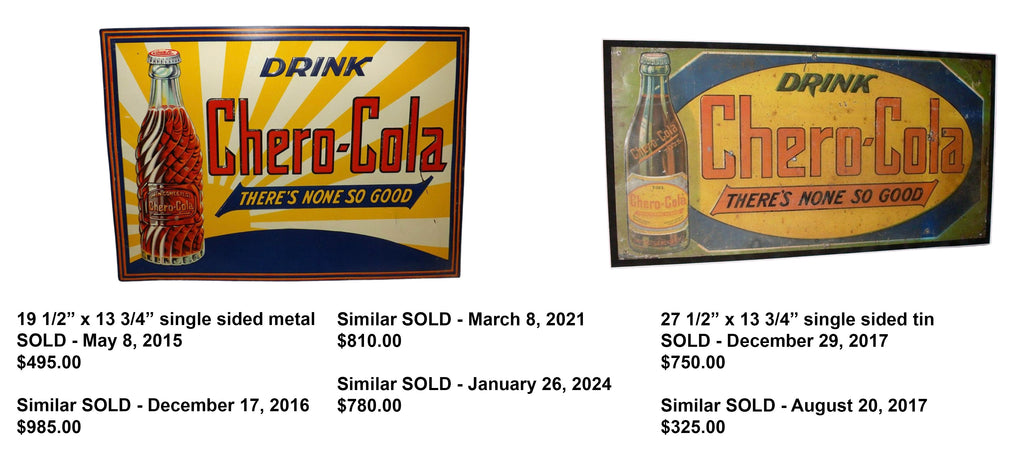
Nehi is the next layer in time. Most of these signs fall between the $1,000 to $2,000 range. There are a few exceptions which are noted below. The 1920s signs with the women’s legs are always desirable, and the signs from the 1930s and 40s are extremely popular right now, especially in when in good shape. Flange signs will go for a little more.
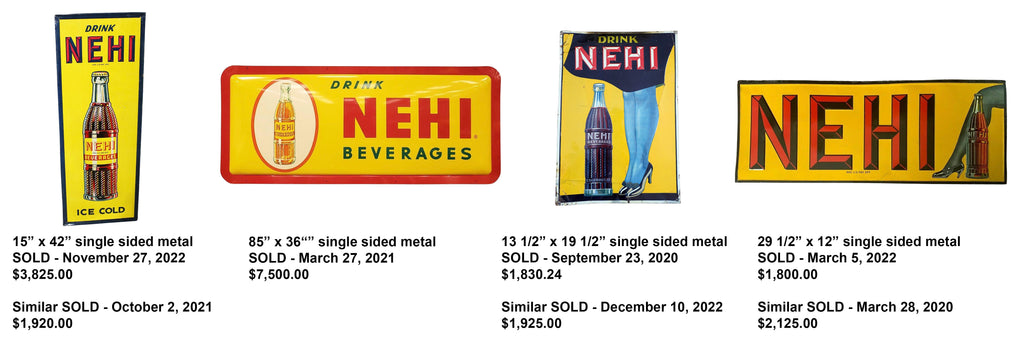
Royal Crown Cola encompasses the range of the previous 2 signs - anywhere from $700 to $2,000. The midcentury signs are more popular, especially because they evoke nostalgia. If one can find a sign at a decent price, it’s not a bad investment to make. If anyone is looking to get into sign collecting, especially with a lean toward soda history, the Chero-Cola, Nehi, Royal Crown realm is a great way to start. There are plenty of examples, and the price range maintains as much of a consistency as possible in the antique and vintage world.
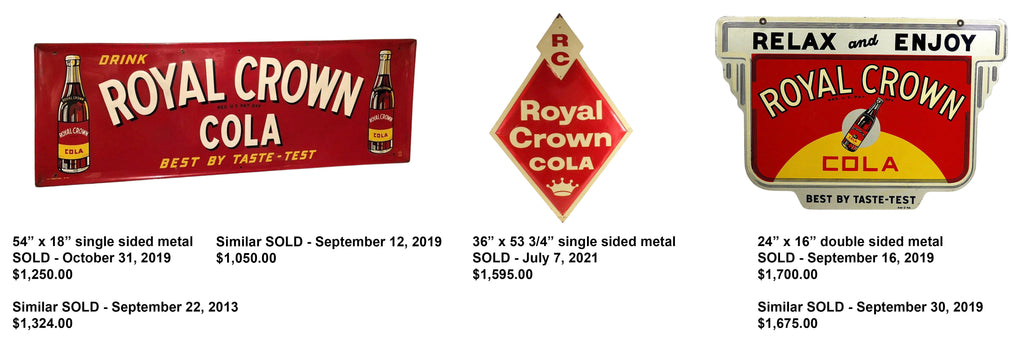
FUN FACTS AND VIDEOS
Here’s some fun facts for you:
In 1958, RC introduced the first diet cola with Diet Rite, and in 1962 introduced the first sodium free RC cola. In 1976, Royal Crown bough Arby’s for $18 million. The 1984 intro of Cherry RC would be a sweeter, less concentrated version of the original Chero-Cola drink. In 2012, RC introduced Jeera which is a cumin-flavored soda for the South Asian market.
“RC Cola and a Moon Pie” by Big Bill Liston was a hillbilly hit in 1950 (listen below), and caused a joke in the south of a ‘working man’s lunch’ by pushing someone through the afternoon with the power of sugar and caffeine. It does work, but fair warning… the come down is a little harsh.
Moon pies were invented in 1917 by Chattanooga Bakery out of Tennessee. This year's RC Cola - MoonPie Festival is June 15, 2024 in historic Bell Buckle, Tennessee. You can find out more HERE. There's also a newer fest in Louisiana you can find HERE.
Can RC Cola be the key to fighting fascism? This 1980s commercial says, "yes."
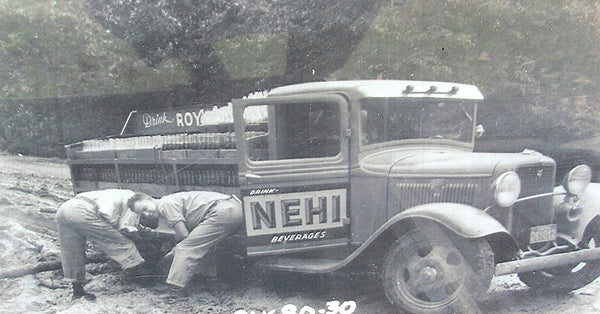




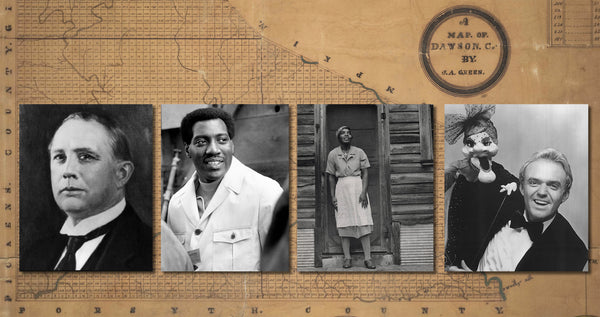


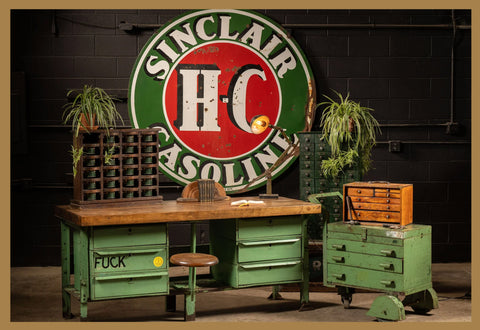








Leave a comment